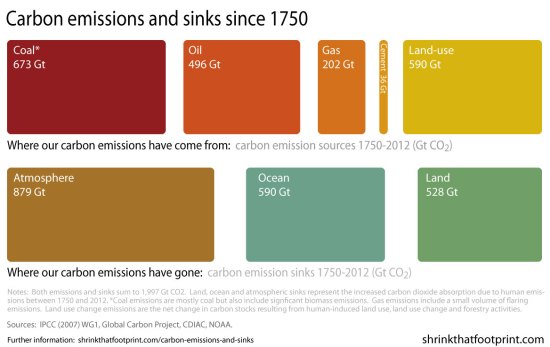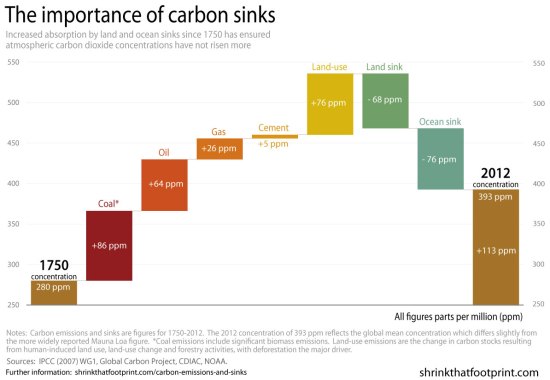The Atmosphere Is Over 400 Parts Per Million Carbon
The world reached a grim milestone recently, with atmospheric concentrations at the historic Mauna Loa observatory hitting the 400 parts per million mark due to ever increasing global carbon emissions.
While this event rightly got the media coverage it deserved, rarely do we stop to appreciate the incredible job land and ocean sinks have played in ensuring this figure isn’t significantly higher.
Using data for all sources and sinks of human carbon emissions over the last 262 years this post highlights just how hard the oceans, plants and soils are working to slow the growth of atmospheric carbon dioxide concentrations.
Global Carbon Emissions And Sinks
Since 1750 the human race has been responsible for 2,000 gigatonnes of carbon dioxide emissions.
These human carbon emissions have added to the much larger natural carbon cycle and resulted in the growing atmospheric concentrations so well documented by the Keeling Curve.

Using data from the IPCC, GCP, and CDIAC we can quantify where human carbon emissions have come from and where those emissions have gone over the last 262 years:
Human induced carbon emissions since the industrial revolution have totaled almost 2,000 Gt CO2. The major sources of emissions have been coal* (34%), oil (25%), gas (10%), cement (2%) and land-use (29%).
Biomass, Flaring And Land Use
A few important caveats for these figures are worth discussing. Coal emissions also include a significant volume of biomass emissions, while dwarfed by coal in recent years biomass emissions were likely dominant until at least 1900 . Biomass burning is the burning of organic material that is derived from plants and animals, such as wood and crop waste. This type of burning is often used to create energy, such as heat and electricity. For natural gas a small share results from flaring, and oil emissions included a very small share from bio-fuel emissions.
Land use emissions represent the net change in carbon stocks resulting from human activities. This includes both increased emissions and reduced sink capacity.
Land, Ocean And Atmospheric Sinks Describe Where CO2 Goes
The figures for the land, ocean and atmospheric sinks describe where these 2,000 Gt CO2 have gone. The three major sinks for human carbon emissions are the atmosphere (44%), the ocean (30%) and the land (26%).
These figures don’t necessarily account for the same molecules of carbon dioxide, but rather how the imbalance created by adding extra human emissions to the natural carbon cycle have affected sink carbon stores.
The carbon dioxide that has been added to the oceans, plants, soils and fungi is the result of both greater emission rates and higher atmospheric concentrations. This results in a kind of negative feedback where ocean and land sinks absorb more carbon dioxide as more is pumped into the air.
Together ocean and plants sinks have absorbed 56% of human carbon emissions since 1750. Without these sinks working overtime atmospheric carbon concentrations would already be well over 500 parts per million (ppm). In the case of the ocean acidification in particular this has not come without a cost.
Carbon Sinks Play A Massive Role In Reducing Carbon
We can take our analysis further by thinking about these carbon emissions and sinks in terms of atmospheric concentrations.
For each 7.8 Gt of carbon dioxide that is added to the atmosphere global concentrations increase by 1 part per million. The 879 Gt of human carbon emissions that have stayed in the atmosphere since 1750 are thus equal to an increase in atmospheric concentrations of 113 ppm.
This extra carbon dioxide has driven global atmospheric concentrations from 280 ppm in 1750 to 393 ppm by 2012. Note this is the annual global average as opposed to the more widely reported Mauna Loa figures.
We can use a similar calculation to understand how all human sources of carbon emissions and carbon sinks relate to the atmospheric concentration of carbon dioxide.
I find the result a powerfully simple way of visualizing how human carbon emissions and carbon sinks affect the atmospheric concentration of CO2 :

The data in this waterfall chart is exactly the same as the previous emissions and sinks analysis, but has been converted to illustrate how emissions and sinks affect atmospheric concentrations.
If all human carbon emissions had remained in the atmosphere over the last 260 years atmospheric carbon concentrations would be 537 ppm, or 257 ppm above where they where in 1750. If we exclude land-use emissions this figure is 460 ppm.
In terms of a parts per million increase the sources of human carbon emissions are equivalent to the following: coal (+86 ppm), oil (+64 ppm), gas (+26 ppm), cement (+5 ppm) and land-use (+ 76 ppm).
Without land and ocean sinks working overtime concentrations of carbon dioxide would be well beyond the 400 ppm recently observed in Hawaii. The ocean sink (-76 ppm) and land sink (-68 ppm) have absorbed 56% of human carbon emissions since 1750, keeping global carbon dioxide concentrations ‘down’ to 393 ppm in 2012.
These natural sinks for carbon dioxide have been crucially important in slowing the growth of atmospheric carbon dioxide in the past.
Future – Carbon Sinks Cannot Absorb All Man-Made Carbon
To keep things as clear as possible this analysis has only looked at cumulative emissions. The limitation of this approach is that it doesn’t tell us much about the annual rates of carbon emission and sink absorption.
The high level story is pretty simple. Human kind is emitting more and more carbon dioxide, as falling land-use emissions are dwarfed by emissions from our growing use of fossil fuels. In reaction to increased emission rates and growing atmospheric concentrations both land and ocean sinks are absorbing more carbon dioxide.
Despite the fact that sinks are absorbing more CO2 the atmospheric concentration is growing at a faster rate than ever. In the decade from 2000-2009 the atmospheric concentration of carbon dioxide grew at an average rate of 2.0 ppm/yr, higher than any previous decade measured. To reduce this growth rate global carbon emissions need to decline. To stop concentrations growing at all would require an immediate reduction in carbon emissions by 55-60%, followed by further reductions in time.
In any future emissions scenario the reaction of our carbon sinks will play a key role in controlling atmospheric carbon concentrations. Hopefully sink absorption will continue to moderate the growth rate of atmospheric carbon, but this is not certain. Plenty of research warns of the dangerous possibilities of sinks becoming sources of emissions. These are the risks of positive feedbacks from things like drought, fire, peat-land dehydration, permafrost melt and out-gassing oceans.
Whenever we talk about tackling the carbon problem it is worth remembering the incredible job the land and ocean sinks do in slowing the growth of atmospheric carbon. This is a good reminder that reducing land use emissions and protecting carbon sinks are also part of the solution.
Lindsay Wilson
I founded Shrink That Footprint in November 2012, after a long period of research. For many years I have calculated, studied and worked with carbon footprints, and Shrink That Footprint is that interest come to life.
I have an Economics degree from UCL, have previously worked as an energy efficiency analyst at BNEF and continue to work as a strategy consultant at Maneas. I have consulted to numerous clients in energy and finance, as well as the World Economic Forum.
When I’m not crunching carbon footprints you’ll often find me helping my two year old son tend to the tomatoes, salad and peppers growing in our upcycled greenhouse.
